Updated: AOpen MiniPC – Imitation is the Sincerest Form of Flattery
by Jarred Walton on March 3, 2006 12:05 AM EST- Posted in
- Systems
Installation and Setup
The installation and setup process for the MiniPC is really a tale of two extremes. AOpen shipped us a pre-built unit, so all I had to do was plug it in, connect an appropriate keyboard and mouse, and it was ready for use. That's how every one of these systems should be sold, because frankly, stuffing the necessary parts into a case this small is going to be a difficult task for most people. Popping open the unit shows just how much room you have to work with, and we would much rather leave the task of putting the computer together to the people on the assembly line. If you have really large hands, if could be difficult, though really having the right tools is the most important part of working with the case.
Four screws underneath the non-slip pad secure the case, and removing them is pretty simple. Once that's done, opening the case still requires some effort, as the top and bottom snap together. After you (carefully) pry it open, you can see the internals, which are packed with all of the required parts. The process of pulling the top and bottom apart is definitely not easy, and given the presence of four screws to hold the two halves together, we would prefer to use less force. All the little metal "teeth" around the sides appear to add a lot of pressure so that even without the screws the top and bottom are in no danger of separating. The metal prongs can also scratch the sides if you're not careful when pulling the case apart or putting it back together.
The motherboard has a single DDR2 SO-DIMM slot, a Mini-PCI slot that is filled with a wireless networking device in some configurations (our unit didn't have WiFi), and a heat sink and fan unit that covers both the CPU and the chipset. It would have been nice to get a second SO-DIMM slot for memory expansion, and most laptops have memory access panels underneath a small hatch to make RAM upgrades easy and quick. That's something for Aopen or their competitors to consider for future designs.
While the HSF is quite small and would certainly be inadequate for cooling higher power CPUs, the 22W TDP Pentium M does perfectly well, and the case under full load was only slightly warm - just like a typical laptop.
The top of the unit has a plastic cage that holds the 2.5" HDD and the slim optical drive. Removing four more screws and a bit more prying gets that out of the way, at which point you can install the HDD and optical drive. Note that the optical drive is a standard laptop form factor, but a slot-loader drive is required. AOpen makes such drives in either a CD-RW/DVD-ROM combo unit or a standard DVD+/-RW drive. A proprietary PCB converts the IDE interface into a connection that slots into the motherboard (which incidentally also helps to hold the top and bottom of the case together). The card then plugs into the connections on the optical drive and HDD - think of it as a solid, compact replacement for the typical ribbon cable.
In the above images, you can also see that there is a built-in speaker that functions as a mono audio output. It isn't very loud and the quality is what you would expect from the size, not to mention that it's concealed behind a metal cover. It will be sufficient for hearing the Windows sound events and listening to audio files where high fidelity isn't a requirement - basically enough for a business environment.
The installation and setup process for the MiniPC is really a tale of two extremes. AOpen shipped us a pre-built unit, so all I had to do was plug it in, connect an appropriate keyboard and mouse, and it was ready for use. That's how every one of these systems should be sold, because frankly, stuffing the necessary parts into a case this small is going to be a difficult task for most people. Popping open the unit shows just how much room you have to work with, and we would much rather leave the task of putting the computer together to the people on the assembly line. If you have really large hands, if could be difficult, though really having the right tools is the most important part of working with the case.
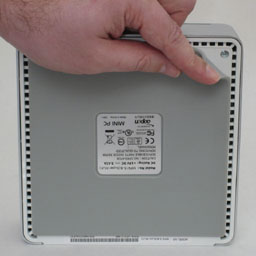 |
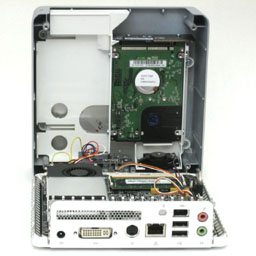 |
| Click on images to enlarge. | |
Four screws underneath the non-slip pad secure the case, and removing them is pretty simple. Once that's done, opening the case still requires some effort, as the top and bottom snap together. After you (carefully) pry it open, you can see the internals, which are packed with all of the required parts. The process of pulling the top and bottom apart is definitely not easy, and given the presence of four screws to hold the two halves together, we would prefer to use less force. All the little metal "teeth" around the sides appear to add a lot of pressure so that even without the screws the top and bottom are in no danger of separating. The metal prongs can also scratch the sides if you're not careful when pulling the case apart or putting it back together.
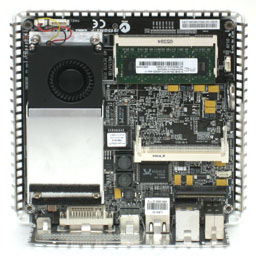 |
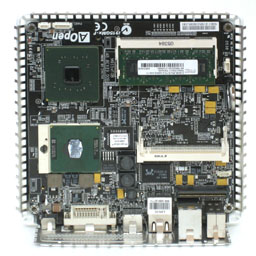 |
| Click on images to enlarge. | |
The motherboard has a single DDR2 SO-DIMM slot, a Mini-PCI slot that is filled with a wireless networking device in some configurations (our unit didn't have WiFi), and a heat sink and fan unit that covers both the CPU and the chipset. It would have been nice to get a second SO-DIMM slot for memory expansion, and most laptops have memory access panels underneath a small hatch to make RAM upgrades easy and quick. That's something for Aopen or their competitors to consider for future designs.
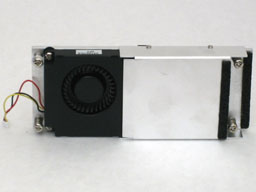 |
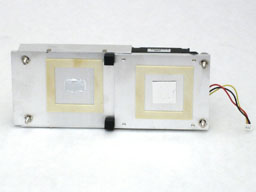 |
| Click on images to enlarge. | |
While the HSF is quite small and would certainly be inadequate for cooling higher power CPUs, the 22W TDP Pentium M does perfectly well, and the case under full load was only slightly warm - just like a typical laptop.
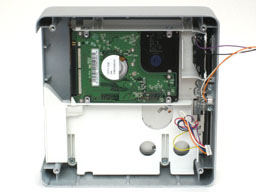 |
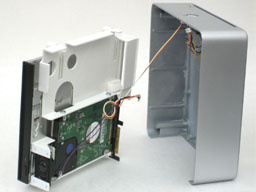 |
| Click on images to enlarge. | |
The top of the unit has a plastic cage that holds the 2.5" HDD and the slim optical drive. Removing four more screws and a bit more prying gets that out of the way, at which point you can install the HDD and optical drive. Note that the optical drive is a standard laptop form factor, but a slot-loader drive is required. AOpen makes such drives in either a CD-RW/DVD-ROM combo unit or a standard DVD+/-RW drive. A proprietary PCB converts the IDE interface into a connection that slots into the motherboard (which incidentally also helps to hold the top and bottom of the case together). The card then plugs into the connections on the optical drive and HDD - think of it as a solid, compact replacement for the typical ribbon cable.
In the above images, you can also see that there is a built-in speaker that functions as a mono audio output. It isn't very loud and the quality is what you would expect from the size, not to mention that it's concealed behind a metal cover. It will be sufficient for hearing the Windows sound events and listening to audio files where high fidelity isn't a requirement - basically enough for a business environment.










54 Comments
View All Comments
Questar - Friday, March 3, 2006 - link
Where else in the x86 market is Apple not price competetive?rowcroft - Friday, March 3, 2006 - link
Considering it's Friday, the new Mac Mini's were announced on Tuesday (one is on a FedEx truck on it's way to my house) the article really shouldn't have the errors that it does. You can certainly tell Anand didn't write this one....JarredWalton - Friday, March 3, 2006 - link
There are a couple places where I mention the fact that this has already been superceded by the new Mac Mini. Considering this product is less than two months old (and really only 1 month in the US), the choice is either to not review it at all or to review it and basically end up with "nice, but unless you're a die-hard Windows user the Mac Mini is better." If it wasn't clear that I think that the Mac Mini is the better choice, I apologize. However, for people dead set on XP, until the MP945 is launched you really don't have any other option that uses a Pentium M chip. The only factual error right now (that is corrected) is that a USB X-Fi doesn't exist, unless you've spotted something else?rowcroft - Saturday, March 4, 2006 - link
I was referring to comments about i386 macs not yet shipping on the first page and overall sense that there the comparable mini's are the one's released a year ago now. I was a bit too harsh though, I apologize for that.JarredWalton - Saturday, March 4, 2006 - link
Oh... heh. That intro page was written a couple weeks ago, then the article got delayed as I waited for some answers and other information. I'll change it to the present tense instead of future tense. Of course, we're still waiting for a "Windows on Intel Macs" solution. I'm betting Vista will be necessary, as I don't know if it's even feasible to get XP runnign on an EFI architecture without massive effort. (First person to prove me wrong gets a pretty sizeable check, I suppose.)Nocturnal - Friday, March 3, 2006 - link
I have worked with many laptops and this unit doesn't look that much different from the pictures although the pictures are probably a little bigger than the actual unit (I think?). Other than that, I'd definately invest in one of these for the wife.themelon - Friday, March 3, 2006 - link
There are quite a few USB audio devices on the market today, including an X-Fi product from Creative.They have a USB X-Fi? It's not on there product page and this is the first time that I have seen mention of one.
JarredWalton - Friday, March 3, 2006 - link
Right you are. I could have sworn I saw a Creative X-Fi USB, but I'm clearly mistaken. The best Creative USB option is still the Audigy 2 NX (right?). I will fix this error.psychobriggsy - Friday, March 3, 2006 - link
Pointless unless you have a Windows based application that you need to use.And for the uses this type of system will be good for, there aren't many of those.
If you want a small system, then the Mac Mini is clearly the better choice, and will be cheaper to boot. AOpen really need to trim their prices when they release their more-equivalent update.
There is still the issue of the market size for a computer this small. In home entertainment systems you have the option of creating a system as large as your standard HiFi separate. Elsewhere the large box can be stuck under the desk. However it is ideal as a zero-configuration computer, one that you'll use until it dies or you replace it.
It feels really odd writing 'Macs are cheaper and better' ...
Hikari - Friday, March 3, 2006 - link
Page two says, "Open has cloned the original Mac Mini with a system that is going to be faster in nearly every area."How old is this review? This isn't even close to as fast as a Mac mini with a Core Duo in it and 945G chipset. You just might want ot make sure you're making it clear that its slower than the old G4-based mini.